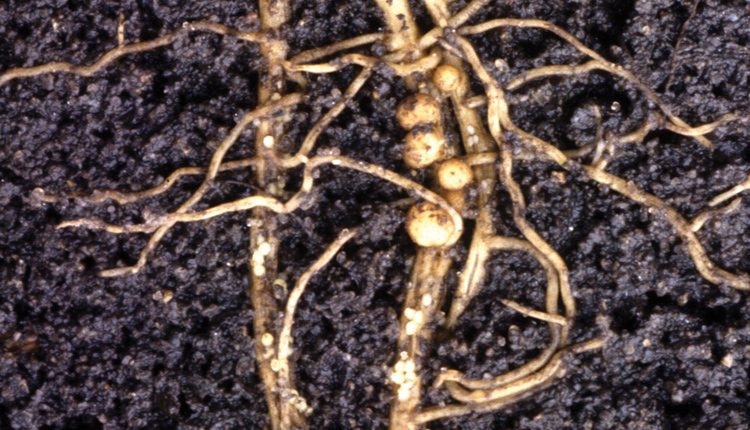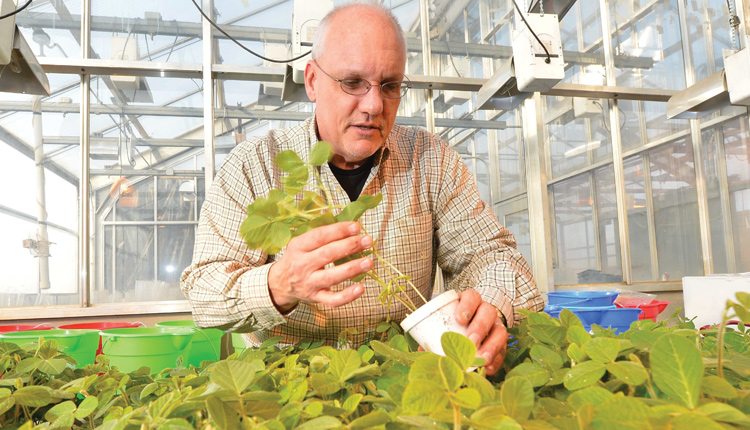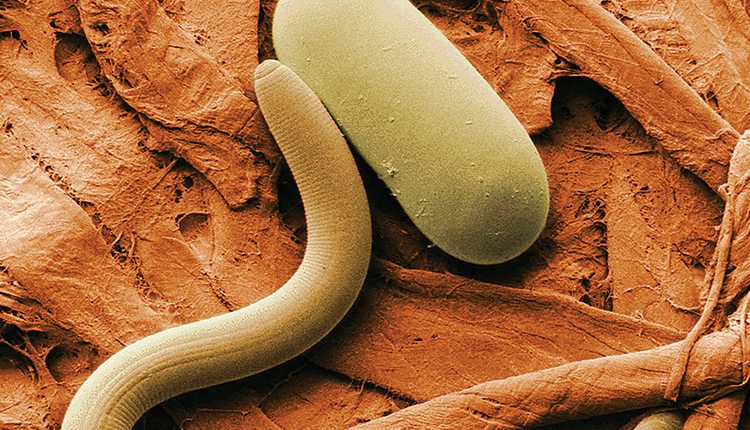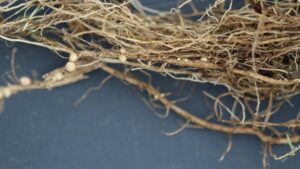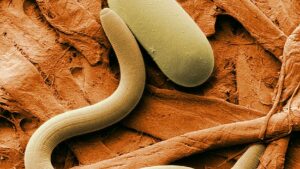Companies work to help farmers battle soybean cyst nematode through traits and seed-applied technologies.
A microscopic roundworm that causes no specific symptoms is the most serious threat to soybean farmers in the United States today.
In fact, Teresa McNeal, Syngenta head of soybean seed product marketing, says the next five most problematic pests don’t add up to that of soybean cyst nematode (SCN). It’s estimated that 128 million bushels are lost annually to SCN in the United States. Some say it’s a $1.5 billion pest.
In general nematodes are responsible for destroying 12 percent of the world’s crop production. Finding protection from these tiny parasites remains one of the greatest challenges facing farmers today.
“The problem with nematodes is that they’re hidden in the ground — it’s hard to get to them,” explains Jürgen Benting, who researches pest control for Bayer CropScience in Monheim, Germany.
To make things more difficult, there are also many different species of nematodes affecting a diverse selection of crops.
First found in North Carolina in 1954, SCN is present in all major soybean production areas. Shawn Conley, a University of Wisconsin Extension soybean specialist, says many growers don’t even know they have a problem until a severe infestation develops, and yield losses due to SCN can be more than 50 percent.
“Understanding the life cycle of SCN, routine soil testing and proper crop management can reduce the incidence of this pest,” he says.
In helping growers manage SCN, Conley says one of the first things you’ll need to know in making recommendations is if SCN is present in the field. Then crop rotation, tillage, variety selection and seed-applied technologies are tools available to manage SCN.
Conley says that soil can be sampled almost any time for the presence of SCN, but fall is often the best time as growers will be planning for the following crop year. “Soil samples can be collected through the year until a significant snowfall or hard freeze occurs,” he says, noting that if you wait to sample until the spring, SCN numbers might be relatively low. “No matter what sampling pattern you use, the more cores you take, the better the estimate of SCN population density across the field.”
Trait Talk
For growers who have SCN pressure in their fields, there are a number of resistant varieties and seed-applied technologies that can help to prevent damage and decrease SCN populations.
One of the most effective tools to help manage SCN is the practice of growing resistant soybean varieties and the number of varieties with genetic resistance to SCN in maturity groups I, II and III has increased dramatically since the early 1990s.
Currently, there are three main genetic sources for SCN resistance genes in commercial soybean varieties: PI88788, Peking and PI437654, according to Iowa State University. There’s also another variety with resistance genes from PI209332 available. Each of these sources of SCN resistance contains several genes that confer resistance to the nematode. Greg Tylka, a professor in the Department of Plant Pathology and Microbiology at Iowa State University, says this means that soybean varieties developed from the various sources of resistance might not all contain the same gene in the same combinations.
All of these sources of SCN resistance allow limited reproduction of only a few nematodes. Limited reproduction by a few nematodes on a resistant soybean variety does not pose a problem in a single growing season; however, if soybean varieties containing the same source of resistance are grown repeatedly for many years, the potential for buildup of a population of nematodes that readily feed on such varieties exists. The use of resistant soybean varieties, particularly any single SCN-resistant variety, should not be considered the sole solution for managing SCN.
Status of Resistance
Researchers are starting to see a loss of effectiveness, Tylka says. “I have observed a slow but steady decrease in effectiveness of PI 88788 resistance against the SCN in Iowa over the past 15 years, and it is becoming a serious concern,” he says.
PI88788 is a common source of genetic resistance to the SCN that was introduced into many soybean varieties to counter the pest. The nematodes cost soybean producers across the United States an estimated more than $1 billion each year in lost yields.
“Midwestern soybean farmers desperately need another type or source of resistance against this widespread pest,” Tylka says.
Tylka was one of a group of nematologists from eight Midwestern states and Ontario that discussed the development at a meeting of the North Central Committee on Practical Management of Nematodes on Corn, Soybeans and Other Crops of Regional Importance (NC1197) in Chaska, Minn. The committee reviews and coordinates ongoing research on managing nematode parasites of crops, with special emphasis on corn and soybeans.
The scientists concluded that a coordinated approach using multiple management options, such as alternating soybeans with non-host crops, planting SCN-resistant soybean varieties and using nematode-protectant seed treatments, provide the greatest likelihood of sustained success for producing soybeans profitably in SCN-infested fields.
They also planned coordinated research projects for upcoming years, including work on nematode-resistant varieties, non-host crops, seed treatments, new nematode detection methods and soil health.
McNeal says while Syngenta has a number of SCN resistant varieties that help, they don’t completely stop the feeding, which is why experts recommend the use of a complementary seed-applied nematicide.
Seed Applied Technologies
Syngenta brought to market Clariva Complete, a seed treatment comprising an insecticide, nematicide and three fungicides, in 2014. McNeal says this combination helps to protect the soybean seed during its early stages of development.
“This combination provides really clear benefits,” she says. “Yield alone is a big deal, but you also get an insecticide and fungicide treatment. The nematicide acts directly on SCNs and it’s a biological.”
She explains that while SCN is the main problem, it can also lead to Sudden Death Syndrome and cause other challenges.
Clariva Complete is still in its infancy in terms of adoption, McNeal says, noting that more than 75 percent of customers saw an addition of 2 bushels per acre to their average yields. Because of this, McNeal expects adoption will continue to grow at a good rate.
“Applying Clariva to varieties that are starting to show resistance adds a second mode of action, helping to reduce the SCN population,” she says.
Bayer recently brought to market another option for growers with its Poncho/VOTiVO seed treatment to help keep nematodes from infesting the roots. VOTiVO contains the bacteria Bacillus firmus, which grow with the plant’s roots to form a living shield around it.
Ken Franklin, a grower from central Illinois who farms about 3,000 acres of corn and soybeans, works with Bayer’s Poncho/VOTiVO, says that in 2014 he had a hard rain but the soybeans lasted a lot longer due to the treatment.
The company also launched ILeVO seed treatment, which has activity against nematodes and helps to protect the soybean root system against the fungus that causes Sudden Death Syndrome.
According to Bayer, combining ILeVO with Poncho/VOTiVO gives growers three modes of action for root and plant protection against the Sudden Death Syndrome fungus, insects and nematodes.
Future Expectations
Looking to the future, Bayer is also working to develop a new microbial-based seed trait. The trait will represent the first microbial-based seed product in the company’s portfolio, according to Liam Condon, chief executive officer for the company. However, he doesn’t expect the trait will be available to U.S. farmers until sometime around 2025, as the product is still in the company’s proof-of-concept stage.
“We believe it has huge potential in most parts of the Midwest soybean growing area,” says Jorg Ellmanns, head of the soybeans, corn and herbicides team within crop strategy and portfolio management. “The first results are extremely positive. The efficacy is very broad and the reduction of nematode counts is huge, but we have to verify that throughout the project development states.”
In the research and development phase, McNeal says researchers at Syngenta are exploring the use of native traits and investigating new sites of action.
“We are always looking to provide the best options for growers,” McNeal says.




